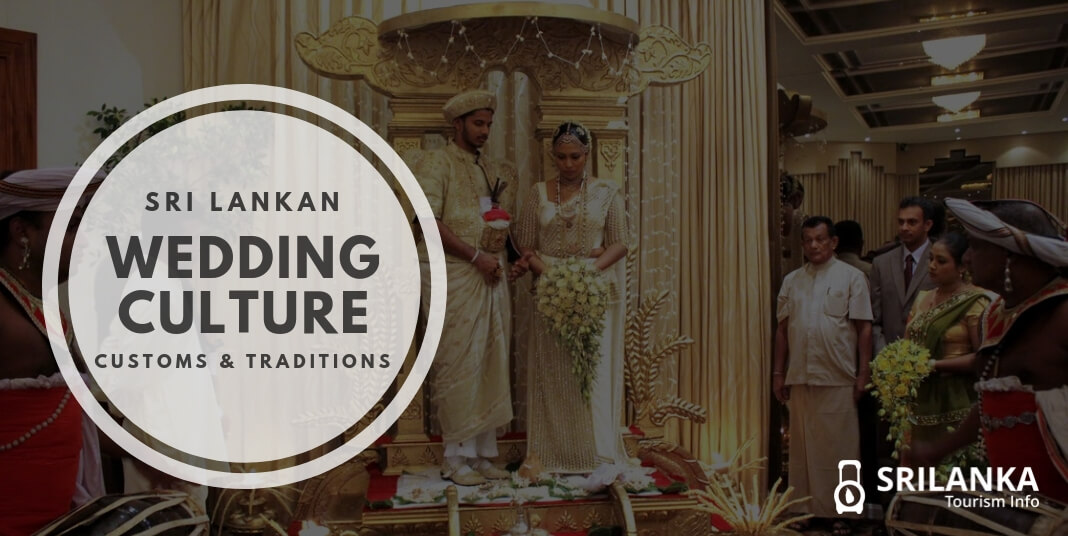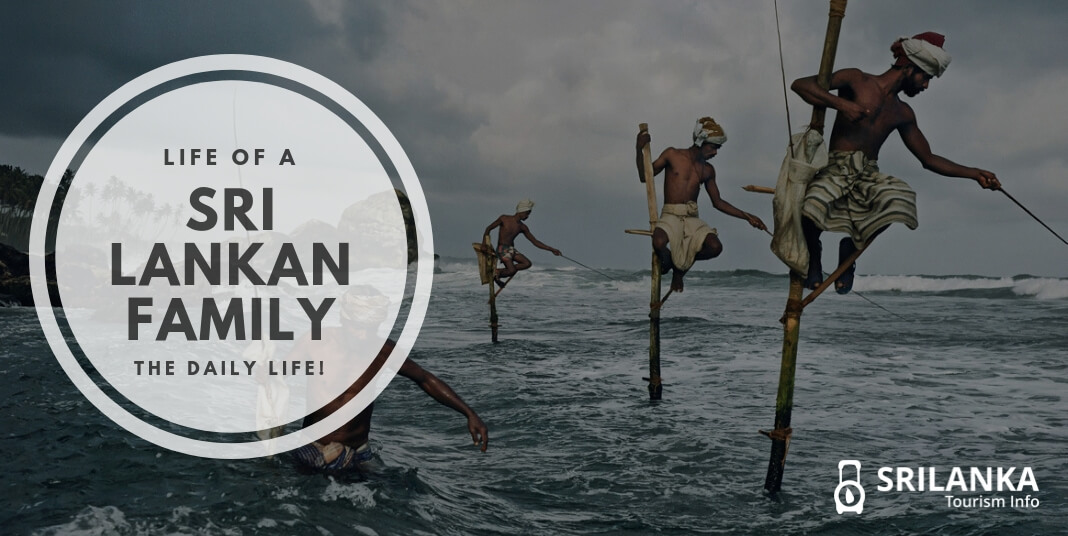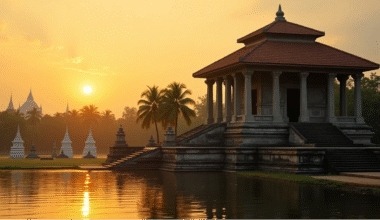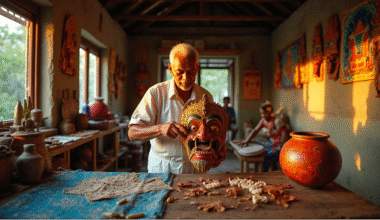The Sri Lankan flag tells a fascinating story through its vibrant colors and distinctive symbols. This national emblem does more than represent a country it serves as a powerful symbol that brings minority groups together with the majority race.
A closer look at the Sri Lankan national flag reveals meaningful symbolism in each element. The maroon background features a golden lion that represents the Sinhalese race. The vertical orange stripe stands for the Tamil population, while the green stripe represents the Muslim minority. The flag’s four corners each contain a Bo leaf, symbolizing Buddhism’s four virtues: kindness, friendliness, happiness, and equanimity. Such thoughtful design reflects the island’s rich heritage that spans more than two millennia of continuous human settlement.
This piece explores the ancient origins of the Sri Lankan flag’s meaning. You’ll learn about how its elements evolved through history, and the vital role each color—saffron, orange, green, maroon, and black plays in representing the nation’s identity and its aspirations for unity among its diverse population.
The ancient roots of the Sri Lankan flag
The Sri Lankan flag’s story spans more than two thousand years and reflects the island’s royal heritage and cultural identity.
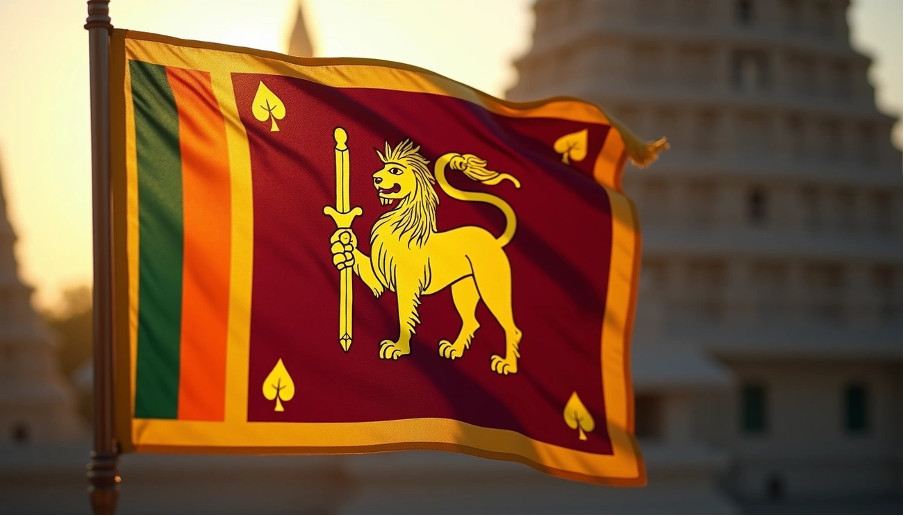
From King Dutugemunu to the Kandyan Kingdom
Sri Lanka’s national flag traces its roots to the island’s ancient kingdoms. Historical records show King Dutugemunu (161-137 BCE) carried a distinctive banner. The banner showed a lion with a sword in its right paw, along with sun and moon symbols during his battle against Tamil king Elara. A mural showing this flag existed in Cave No. 2 at Dambulla Viharaya until vandals damaged it in 1957.
The lion remained a powerful symbol through successive kingdoms. The Kandyan Kingdom, Sri Lanka’s last independent realm before colonial rule, kept the lion flag tradition alive until its fall in 1815. King Sri Vikrama Rajasinha’s reign (1798-1815) saw a golden lion adorning a red background as one of the royal standards.
The lion symbol in early Sinhalese banners
Prince Vijaya’s arrival around the 5th century BCE marked the lion emblem’s beginnings. Legend tells us Vijaya came from Sinhapura (“Lion City”) in India, which created the lasting bond between lions and Sinhalese identity.
The symbol grew more meaningful over time. The 16th century saw the lion becoming closely tied to kingship, appearing on royal artifacts. Two ivory caskets given to Portuguese kings by Kotte’s rulers featured lion decorations, showing this connection.

Colonial suppression and rediscovery in 1948
The British Empire replaced the Lion Flag with the Union Flag after the Kandyan Convention of 1815, ending native monarchy. They took the original flag to England, storing it at the Royal Hospital Chelsea.
The independence movement brought new hope. E.W. Perera and D.R. Wijewardena found the original Lion Flag in Chelsea in 1908. Dinamina newspaper published its photograph in a special edition marking 100 years since self-rule ended. Many Sri Lankans saw the authentic design for the first time since the Kandyan Kingdom’s fall.
D.S. Senanayake, Ceylon’s first Prime Minister, raised the Lion Flag proudly during the independence ceremony on February 4, 1948. This moment symbolized the nation reclaiming its sovereignty and heritage.
Symbolism behind each element of the national flag
The Sri Lankan flag’s elements tell a rich story that captures the nation’s heritage and dreams in a variety of ways.
The lion and its sword: strength and sovereignty
A golden lion stands proudly at the Sri Lankan national flag’s center. This symbol represents the Sinhalese ethnicity and shows the nation’s strength, bravery, and resilience. The majestic creature’s right forepaw grips a kastane sword, which represents the country’s sovereignty and independence. The lion’s features hold deeper meaning too. Its curly mane shows religious observance, wisdom, and meditation, while its beard represents pure speech. The lion’s nose symbolizes intelligence. The sword’s handle represents four classical elements – water, fire, air, and earth.
Bo leaves and the four Buddhist virtues
Golden Bo leaves grace each corner of the maroon background. These leaves come from Buddhist tradition and point to the sacred Bo tree where Buddha reached enlightenment. Each leaf stands for one of the four Buddhist virtues:
- Metta: Loving-kindness toward all beings
- Karuna: Compassion for those who suffer
- Mudita: Sympathetic joy in others’ happiness
- Upekkha: Equanimity or even-mindedness
Orange and green stripes: ethnic harmony
The flag’s left side features a vertical orange stripe that represents the Tamil community, while the green stripe symbolizes the Muslim population. These elements, combined with the central lion emblem, show Sri Lanka’s steadfast dedication to recognizing and honoring its ethnic diversity.
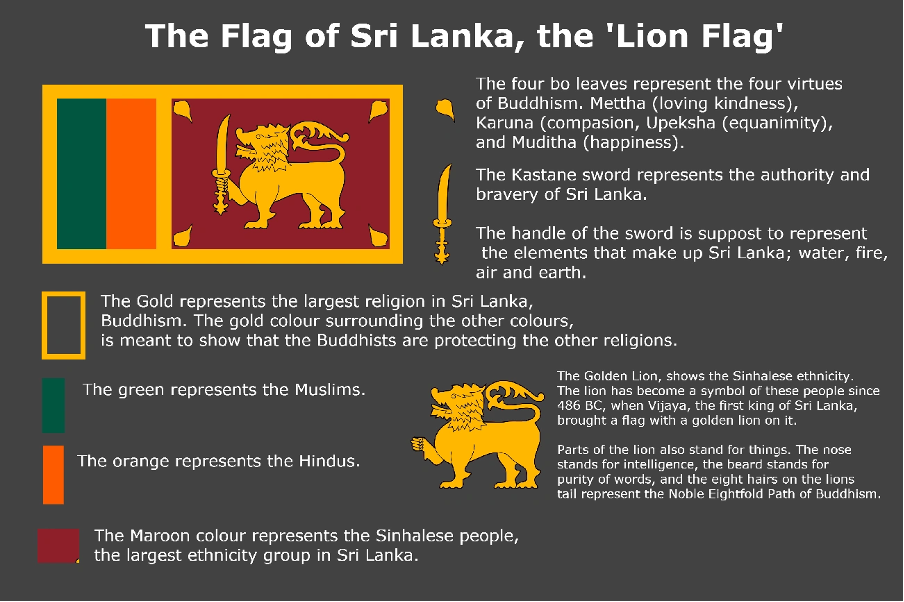
The maroon background and golden border
The maroon background represents the Sinhalese majority. A golden-yellow border wraps around the flag and symbolizes other minority communities, including the Malays, Burghers, Indigenous Veddas, and Sri Lankan Chinese. This design reflects the nation’s hope for unity while celebrating its diverse heritage.
Color codes and design standards of the Sri Lanka flag
The Sri Lankan flag follows strict design standards and color specifications that are detailed in SLS 1:2020, the official document for Sri Lanka’s national flag.
Official HEX, RGB, and CMYK values
The Sri Lankan flag displays five distinct colors with exact digital and print specifications. These color values work best for digital reproduction:
- Yellow/Ripe Mango: HEX #F7B718, RGB 247-183-24, CMYK 0-26-90-3
- Maroon/Violet-Red: HEX #941E32, RGB 148-30-50, CMYK 0-80-66-42
- Orange/Saffron: HEX #DF7500, RGB 223-117-0, CMYK 0-48-100-13
- Green/Teal: HEX #005F56, RGB 0-95-86, CMYK 100-0-9-63
- Black (for outlines): Standard black values
Pantone and RAL references
Professional printers use these standardized Pantone color references to produce the Sri Lankan flag:
- Yellow: Pantone 14-0957 TCX
- Maroon: Pantone 19-1863 TCX[162]
- Orange/Saffron: Pantone 16-1164 TCX[162]
- Green: Pantone 18-5322 TCX[162]
RAL color system matches include RAL 1018 for yellow, RAL 3003 for maroon, RAL 2011 for orange, and RAL 6036 for green.
Design proportions and layout rules
The Sri Lankan national flag maintains a width-to-length ratio of 1:2 as specified in the standard. Each vertical stripe’s width equals 1:7 of the flag’s length, not counting the yellow border.
The flag showcases a yellow border with two vertical stripes – green on the left and saffron next to it. A yellow strip separates the saffron stripe from the red background that features the yellow lion symbol. The lion faces the saffron stripe and holds an upright sword in its right fore-paw. Yellow bo-leaves appear in the red background’s corners, and black outlines highlight all elements.
Modern usage and cultural significance
The Sri Lankan flag stands as a powerful symbol that unites the nation, though its use sometimes creates debate in a variety of communities.
Where the flag is flown today
Sri Lanka’s national flag waves proudly at government buildings, schools, and public spaces across the country. The flag at Galle Face Green in Colombo follows strict rules – it goes up at 6:00 AM and comes down at 6:00 PM daily. Beyond national borders, proud Sri Lankans have carried their flag to remarkable places. A recent example was the 2023 summit of Mt. Elbrus, Europe’s highest peak.
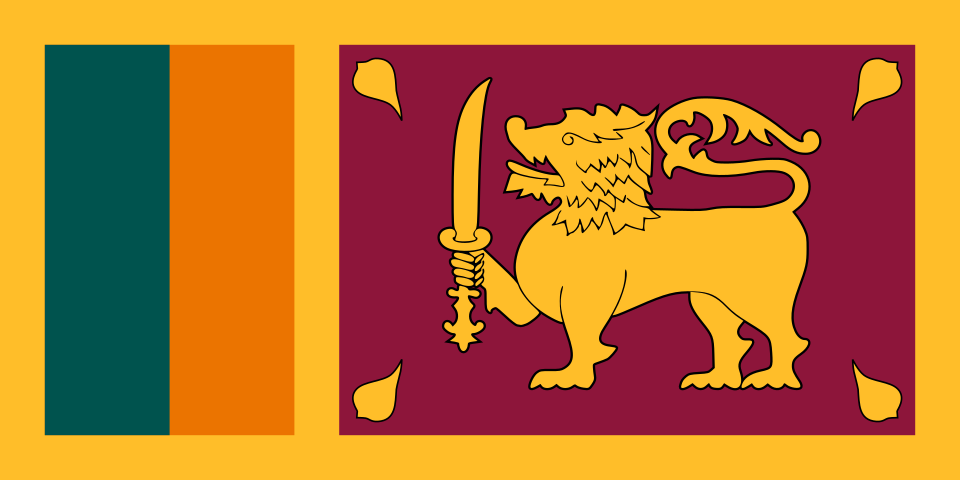
Role in national celebrations and sports
The Sri Lankan national flag takes center stage during independence day celebrations every February 4th. The President raises the flag with military commanders at his side, while the national anthem plays and cultural performances follow. All the same, Sri Lanka faces a serious challenge in sports. By August 2026, the country could see its flag banned from the Olympic Games, Paralympics, and other major international sporting events if its anti-doping agency fails to meet compliance standards.
Representation in provincial and military flags
Provincial flags emerged in 1987-1988, with the Northern and Eastern provinces getting separate flags in 2007 after their administrative split. These flags, which draw from ancient Sinhalese symbols, rarely appear in public. Military colors once served as crucial battlefield rallying points. Now they feature the national flag with unit-specific changes.
Controversies and public perception
The Sri Lankan flag triggers vastly different responses among ethnic communities. Many Tamils, especially in the Northern Province, see the lion symbol as a sign of ethnic oppression rather than unity. This view sometimes leads officials to skip displaying the flag at certain events. These actions highlight the ongoing tensions about national symbols in post-civil war Sri Lanka.
Conclusion
The Sri Lankan flag stands as a powerful symbol with a rich history dating back over two millennia. This national emblem may look simple but tells a complex story of heritage, diversity, and unity. A golden lion with a sword represents the Sinhalese majority’s strength and sovereignty, while orange and green stripes acknowledge Tamil and Muslim communities.
The colors play meaningful roles beyond their visual appeal. A maroon background combines with a golden border and strategically placed Bo leaves to showcase Sri Lanka’s religious and cultural foundations. On top of that, it features four Bo leaves that represent Buddhist virtues – kindness, compassion, joy, and equanimity. These elements connect the national symbol to spiritual traditions that have shaped the country through centuries.
The emblem has evolved with the nation from King Dutugemunu’s ancient banner to today’s flag at Galle Face Green. Its rediscovery and restoration during independence marked a triumphant return to self-governance. The Sri Lankan flag you see today represents more than a national symbol – it embodies the country’s hopes for unity amid diversity.
The flag gets more and thus encourages more varied reactions among different communities. These mixed views reflect the country’s path toward reconciliation after decades of civil conflict. Without doubt, it remains both a testament to ancient heritage and a visual statement of Sri Lanka’s complex modern identity.
Key Takeaways
The Sri Lankan flag is a masterpiece of symbolic design that weaves together over 2,000 years of history, cultural diversity, and national aspirations into one powerful emblem.
- The golden lion traces back to King Dutugemunu (161-137 BCE), representing Sinhalese heritage and national sovereignty through centuries of royal dynasties.
- Each color serves a specific purpose: orange represents Tamils, green symbolizes Muslims, maroon signifies the Sinhalese majority, and golden borders honor other minorities.
- Four Bo leaves in each corner represent Buddhist virtues of loving-kindness, compassion, sympathetic joy, and equanimity, connecting the flag to spiritual foundations.
- The flag follows strict design standards with precise color codes (HEX, RGB, CMYK, Pantone) and a mandatory 1:2 width-to-length ratio for official reproduction.
- Despite its unifying design intent, the flag remains controversial among some Tamil communities who view the lion symbolism as representing ethnic oppression rather than unity.
The flag’s journey from ancient royal banners through colonial suppression to modern independence demonstrates how national symbols can both unite and divide, reflecting Sri Lanka’s ongoing quest for reconciliation and inclusive national identity.
FAQs
Q1. What is the symbolism behind the colors in the Sri Lankan flag? The Sri Lankan flag uses colors to represent different ethnic groups and values. The maroon background symbolizes the Sinhalese majority, while the orange stripe represents the Tamil community and the green stripe represents the Muslim population. The golden border surrounding the flag symbolizes other minority communities in Sri Lanka.
Q2. How did the lion symbol become part of the Sri Lankan flag? The lion symbol has ancient roots in Sri Lankan history, dating back to King Dutugemunu in the 2nd century BCE. It represents the Sinhalese ethnicity and symbolizes the nation’s strength and sovereignty. The symbol continued through various kingdoms and was rediscovered and incorporated into the national flag upon independence in 1948.
Q3. What do the Bo leaves in the corners of the flag represent? The four golden Bo leaves in each corner of the Sri Lankan flag represent the four Buddhist virtues: Metta (loving-kindness), Karuna (compassion), Mudita (sympathetic joy), and Upekkha (equanimity). These leaves also reference the sacred Bo tree under which Buddha attained enlightenment.
Q4. Are there specific design standards for the Sri Lankan flag? Yes, the Sri Lankan flag follows strict design standards outlined in SLS 1:2020. It must maintain a precise width-to-length ratio of 1:2 and use specific color codes for digital and print reproduction. The width of each vertical stripe must be 1/7 of the flag’s length, excluding the yellow border.
Q5. How is the Sri Lankan flag perceived by different communities in the country? While the flag is intended to be a unifying symbol, it evokes different responses among ethnic communities. For many Sinhalese, it represents national pride and heritage. However, some Tamil communities, particularly in the Northern Province, view the lion symbolism as representing ethnic oppression rather than unity, reflecting ongoing tensions in post-civil war Sri Lanka.


